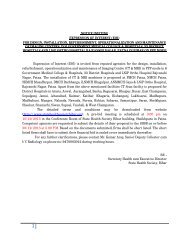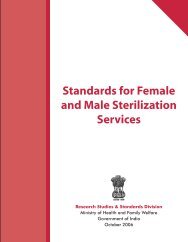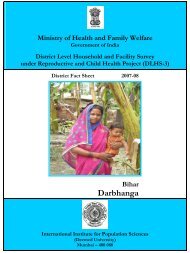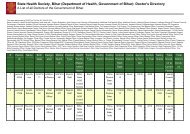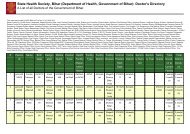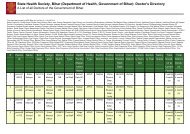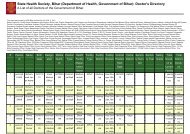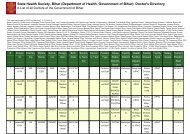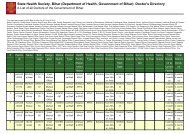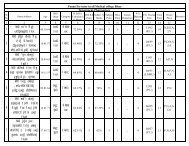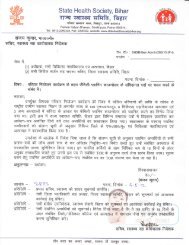District Health Action Plan - STATE HEALTH SOCIETY-----BIHAR
District Health Action Plan - STATE HEALTH SOCIETY-----BIHAR
District Health Action Plan - STATE HEALTH SOCIETY-----BIHAR
You also want an ePaper? Increase the reach of your titles
YUMPU automatically turns print PDFs into web optimized ePapers that Google loves.
PART – F<br />
National Vector Borne Disease Control Programme<br />
The NVBDCP was initiated in the year 2003-2004. It is an umbrella programme for<br />
prevention and control of vector borne diseases including Malaria, Filaria, Kala-azar and<br />
Dengue. Under the programme comprehensive and multi sectoral public health activities are<br />
implemented. <strong>District</strong>s teams should review incidence and prevalence data available for these<br />
diseases in the district through surveillance activities and plan as per national strategy<br />
adapted to address local needs. Vector borne diseases like Malaria, Kala-azar , Dengue and<br />
Japanese encephalitis are outbreak prone diseases and therefore during formulation of the<br />
district health plan, epidemic response mechanism should also be outlined.<br />
The main objectives of NVBDCP are:<br />
� To reduce mortality and morbidity due to Malaria<br />
� To reduce percentage of PF cases.<br />
� To control other vector borne diseases like Kala azar, Dengue, Filaria,<br />
Chikungyniea etc.<br />
Saran is a Kala azar & Malaria prone district of Bihar .<br />
B.3.1 Malaria<br />
Malaria is a life-threatening parasitic disease transmitted by mosquitoes. It was once thought<br />
that the disease came from fetid marshes, hence the name mal aria, (bad air). In 1880,<br />
scientists discovered the real cause of malaria a one-cell parasite called plasmodium. Later<br />
they discovered that the parasite is transmitted from person to person through the bite of a<br />
female Anopheles mosquito, which requires blood to nurture her eggs.<br />
Today approximately 40% of the world's population mostly those living in the world‟s<br />
poorest countries are at risk of malaria. The disease was once more widespread but it was<br />
successfully eliminated from many countries with temperate climates during the mid 20th<br />
century. Today malaria is found throughout the tropical and sub-tropical regions of the world<br />
and causes more than 300 million acute illnesses and at least one million deaths annually.<br />
There are four types of human malaria Plasmodium vivax,<br />
P. malariae, P. ovale and P. falciparum.<br />
P. vivax and P. falciparum are the most<br />
common and falciparum the most<br />
deadly type of malaria infection.<br />
The malaria parasite enters the human<br />
host when an infected Anopheles<br />
mosquito takes a blood meal. Inside<br />
the human host, the parasite undergoes<br />
a series of changes as part of its<br />
complex life-cycle. Its various stages<br />
allow plasmodia to evade the immune<br />
101 | P a g e D i s t r i c t H e a l t h A c t i o n P l a n 2 0 1 2 - 1 3 D H S , S a r a n



